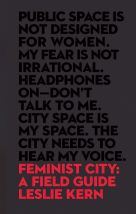Feminist City: A Field Guide

The idea that cities are fundamentally unsafe for women, and that women migrating to cities are turning their backs on domesticated safe areas, is not new. Kern writes that in Victorian London, many people were concerned about the rubbing of shoulders across gender and class lines that was a core part of urban life. Thus, “women’s gradually expanding freedoms were thus met with moral panic over everything from sex work to bicycles” (page 2). “Public woman” was synonymous with sex worker, for instance, driving home the message that women’s sphere was rightly the private home or the country space. In Paris in the 1870s, one compromise was the department store, which was created explicitly as a public space intended for (affluent) women. Gendered moral panics have taken different forms since then.
Urban planners and policymakers tend to be male, and their blind spots about gendered urban obstacles means that those obstacles are perpetuated. Even navigating a city without expecting to be harassed is an experience generally only available to (some) men. The inaccessibility of many London Underground stations for prams (or wheelchairs), Toronto’s guidelines for wind effects that are based on a male “standard person”, and Delhi’s long queues for scarce women’s toilets are other examples of men's constructed position as the default urban dwellers.
Feminist City gives examples of alternatives, including Vienna’s gender mainstreaming in urban planning and slum upgrading in Namibia that makes women decision-makers. Even the decision of which snowy streets to plow first can benefit from a gendered perspective, like Stockholm prioritizing sidewalks, bike lanes and day care areas rather than car-dominated streets.
The book explains the basics of feminist geography and animates these with observations from Kern’s life. For instance, Gerda Wekerle’s assertion that “a woman’s place is in the city” recognizes that the many tasks inside and outside the home expected of women are more convenient to tackle in a dense urban environment, rather than a spread-out suburban one. Yet Kern’s experiences of motherhood while relying on Toronto’s public transport have been exhausting, despite the seeming convenience.
The text is more accessible than academic. Kern is equally comfortable describing TV plots and feminist scholarship. She also gives weight to aspects of urban women's lives that are perhaps under-discussed by researchers, such as the ways shared city spaces can facilitate female friendships.
In order to make cities more navigable by women of different classes, races, bodies, sexualities, ages and experiences, Kern calls for reimagining these spaces to be more communal, whether in caregiving co-ops or housing intended for friends rather than an idealized heteronormative norm. She questions gentrifying forces that pit certain groups of women against each other. And she urges more representation of overlooked groups, including women, in decision-making on cities. Feminist cities are possible, the book argues.
Further reading:
Environment and Urbanization (2012), “Gender and urban change”, Vol 25, No 1, available at https://journals.sagepub.com/toc/eaua/25/1.
Joshi, Nupur (2017), “Low-income women’s right to sanitation services in city public spaces: a study of waste picker women in Pune”, Environment and Urbanization Vol 30, No 1, pages 249–264, available at https://journals.sagepub.com/doi/full/10.1177/0956247817744932.
Whitzman, Carolyn, Caroline Andrew and Kalpana Viswanath (2014), “Partnerships for women’s safety in the city: “four legs for a good table””, Environment and Urbanization Vol 26, No 2, pages 443–456, available at https://journals.sagepub.com/doi/full/10.1177/0956247814537580.
Book note prepared by Christine Ro
Search the Book notes database
Our Book notes database contains details and summaries of all the publications included in Book notes since 1993 - with details on how to obtain/download.
Use the search form above, or visit the Book notes landing page for more options and latest content.
For a searchable database for papers in Environment and Urbanization, go to http://eau.sagepub.com/

